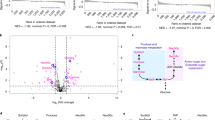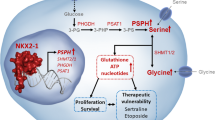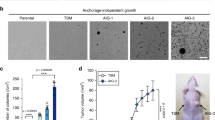Abstract
Tumors have high energetic and anabolic needs for rapid cell growth and proliferation1, and the serine biosynthetic pathway was recently identified as an important source of metabolic intermediates for these processes2,3. We integrated metabolic tracing and transcriptional profiling of a large panel of non–small cell lung cancer (NSCLC) cell lines to characterize the activity and regulation of the serine/glycine biosynthetic pathway in NSCLC. Here we show that the activity of this pathway is highly heterogeneous and is regulated by NRF2, a transcription factor frequently deregulated in NSCLC. We found that NRF2 controls the expression of the key serine/glycine biosynthesis enzyme genes PHGDH, PSAT1 and SHMT2 via ATF4 to support glutathione and nucleotide production. Moreover, we show that expression of these genes confers poor prognosis in human NSCLC. Thus, a substantial fraction of human NSCLCs activates an NRF2-dependent transcriptional program that regulates serine and glycine metabolism and is linked to clinical aggressiveness.
This is a preview of subscription content, access via your institution
Access options
Subscribe to this journal
Receive 12 print issues and online access
$209.00 per year
only $17.42 per issue
Buy this article
- Purchase on SpringerLink
- Instant access to full article PDF
Prices may be subject to local taxes which are calculated during checkout






Similar content being viewed by others
Change history
15 February 2016
In the version of this article initially published, the colors of the lines in the key in the top right corner of Figure 5h were incorrect. The line labeled "High" should be red and the line labeled "Low" should be blue. The error has been corrected in the HTML and PDF versions of the article.
References
Vander Heiden, M.G., Cantley, L.C. & Thompson, C.B. Understanding the Warburg effect: the metabolic requirements of cell proliferation. Science 324, 1029–1033 (2009).
Locasale, J.W. et al. Phosphoglycerate dehydrogenase diverts glycolytic flux and contributes to oncogenesis. Nat. Genet. 43, 869–874 (2011).
Possemato, R. et al. Functional genomics reveal that the serine synthesis pathway is essential in breast cancer. Nature 476, 346–350 (2011).
Mullarky, E., Mattaini, K.R., Vander Heiden, M.G., Cantley, L.C. & Locasale, J.W. PHGDH amplification and altered glucose metabolism in human melanoma. Pigment Cell Melanoma Res. 24, 1112–1115 (2011).
Barretina, J. et al. The Cancer Cell Line Encyclopedia enables predictive modelling of anticancer drug sensitivity. Nature 483, 603–607 (2012).
Mootha, V.K. et al. PGC-1α–responsive genes involved in oxidative phosphorylation are coordinately downregulated in human diabetes. Nat. Genet. 34, 267–273 (2003).
Subramanian, A. et al. Gene set enrichment analysis: a knowledge-based approach for interpreting genome-wide expression profiles. Proc. Natl. Acad. Sci. USA 102, 15545–15550 (2005).
Ye, J. et al. Pyruvate kinase M2 promotes de novo serine synthesis to sustain mTORC1 activity and cell proliferation. Proc. Natl. Acad. Sci. USA 109, 6904–6909 (2012).
Miyamoto, N. et al. Transcriptional regulation of activating transcription factor 4 under oxidative stress in retinal pigment epithelial ARPE-19/HPV-16 cells. Invest. Ophthalmol. Vis. Sci. 52, 1226–1234 (2011).
Afonyushkin, T. et al. Oxidized phospholipids regulate expression of ATF4 and VEGF in endothelial cells via NRF2-dependent mechanism: novel point of convergence between electrophilic and unfolded protein stress pathways. Arterioscler. Thromb. Vasc. Biol. 30, 1007–1013 (2010).
Ye, P. et al. Nrf2- and ATF4-dependent upregulation of xCT modulates the sensitivity of T24 bladder carcinoma cells to proteasome inhibition. Mol. Cell. Biol. 34, 3421–3434 (2014).
He, C.H. et al. Identification of activating transcription factor 4 (ATF4) as an Nrf2-interacting protein. Implication for heme oxygenase-1 gene regulation. J. Biol. Chem. 276, 20858–20865 (2001).
Harding, H.P. et al. Regulated translation initiation controls stress-induced gene expression in mammalian cells. Mol. Cell 6, 1099–1108 (2000).
Hayes, J.D. & McMahon, M. NRF2 and KEAP1 mutations: permanent activation of an adaptive response in cancer. Trends Biochem. Sci. 34, 176–188 (2009).
Kim, Y.R. et al. Oncogenic NRF2 mutations in squamous cell carcinomas of oesophagus and skin. J. Pathol. 220, 446–451 (2010).
Konstantinopoulos, P.A. et al. Keap1 mutations and Nrf2 pathway activation in epithelial ovarian cancer. Cancer Res. 71, 5081–5089 (2011).
Seng, S. et al. NRP/B mutations impair Nrf2-dependent NQO1 induction in human primary brain tumors. Oncogene 28, 378–389 (2009).
Zhang, P. et al. Loss of Kelch-like ECH-associated protein 1 function in prostate cancer cells causes chemoresistance and radioresistance and promotes tumor growth. Mol. Cancer Ther. 9, 336–346 (2010).
Shibata, T. et al. Cancer related mutations in NRF2 impair its recognition by Keap1-Cul3 E3 ligase and promote malignancy. Proc. Natl. Acad. Sci. USA 105, 13568–13573 (2008).
Solis, L.M. et al. Nrf2 and Keap1 abnormalities in non–small cell lung carcinoma and association with clinicopathologic features. Clin. Cancer Res. 16, 3743–3753 (2010).
Singh, A. et al. RNAi-mediated silencing of nuclear factor erythroid-2–related factor 2 gene expression in non–small cell lung cancer inhibits tumor growth and increases efficacy of chemotherapy. Cancer Res. 68, 7975–7984 (2008).
DeNicola, G.M. et al. Oncogene-induced Nrf2 transcription promotes ROS detoxification and tumorigenesis. Nature 475, 106–109 (2011).
Ohta, T. et al. Loss of Keap1 function activates Nrf2 and provides advantages for lung cancer cell growth. Cancer Res. 68, 1303–1309 (2008).
Mitsuishi, Y. et al. Nrf2 redirects glucose and glutamine into anabolic pathways in metabolic reprogramming. Cancer Cell 22, 66–79 (2012).
Singh, A. et al. Transcription factor NRF2 regulates miR-1 and miR-206 to drive tumorigenesis. J. Clin. Invest. 123, 2921–2934 (2013).
Cheng, T. et al. Pyruvate carboxylase is required for glutamine-independent growth of tumor cells. Proc. Natl. Acad. Sci. USA 108, 8674–8679 (2011).
Mullen, A.R. et al. Reductive carboxylation supports growth in tumour cells with defective mitochondria. Nature 481, 385–388 (2012).
Yuan, M., Breitkopf, S.B., Yang, X. & Asara, J.M. A positive/negative ion-switching, targeted mass spectrometry–based metabolomics platform for bodily fluids, cells, and fresh and fixed tissue. Nat. Protoc. 7, 872–881 (2012).
Shedden, K. et al. Gene expression–based survival prediction in lung adenocarcinoma: a multi-site, blinded validation study. Nat. Med. 14, 822–827 (2008).
Rädle, B. et al. Metabolic labeling of newly transcribed RNA for high resolution gene expression profiling of RNA synthesis, processing and decay in cell culture. J. Vis. Exp. 10.3791/50195 (8 August 2013).
Meylan, E. et al. Requirement for NF-κB signalling in a mouse model of lung adenocarcinoma. Nature 462, 104–107 (2009).
Acknowledgements
We thank G. Poulogiannis for bioinformatics advice and H. Abbasi, C. Klimko and M. Yuan for technical support with mass spectrometry experiments. This work was supported by US National Institutes of Health grants P01 CA117969 and R01 GM041890 (L.C.C.), R01 CA157996-01 (R.J.D.), 5R01 CA152301 (Y.X.) and P50 CA70907 (J.D.M., I.I.W., Y.X. and K.E.H.) and by Cancer Prevention Research Institute of Texas (CPRIT) funding to J.D.M., Y.X., I.I.W. and K.E.H. (RP110708 and RP120732) and R.J.D. (RP130272). P.-H.C. was supported by a grant from the Welch Foundation to R.J.D. (I-1733). The mass spectrometry work was partially supported by US National Institutes of Health grants 5P30 CA006516 and 5 P01 CA120964 (J.M.A.). G.M.D. was the Malcolm A.S. Moore Hope Funds for Cancer Research Fellow and is supported by the PanCAN/AACR Pathway to Leadership grant.
Author information
Authors and Affiliations
Contributions
G.M.D., R.J.D. and L.C.C. designed the study. G.M.D. and E.M. performed molecular biology experiments. G.M.D., P.-H.C., E.M., J.A.S., Z.H. and J.M.A. performed metabolomics and isotope labeling and analyzed the data. D.W. performed xenograft experiments. H.T. and Y.X. performed bioinformatics analysis. K.E.H., I.I.W. and J.D.M. contributed highly annotated lung cancer cell lines. G.M.D., E.M. and L.C.C. wrote the manuscript. All authors commented on the manuscript.
Corresponding author
Ethics declarations
Competing interests
L.C.C. owns equity in, receives compensation from and serves on the Board of Directors and Scientific Advisory Board of Agios Pharmaceuticals. Agios Pharmaceuticals is identifying metabolic pathways in cancer cells and developing drugs to inhibit such enzymes to disrupt tumor cell growth and survival. R.J.D. is on the scientific advisory boards of Agios Pharmaceuticals and Peloton Therapeutics. Peloton Therapeutics is developing drugs to target altered molecular pathways in cancer, including altered metabolism.
Supplementary information
Supplementary Text and Figures
Supplementary Figures 1–22, Supplementary Tables 2–5 and Supplementary Note. (PDF 6832 kb)
Supplementary Table 1
Gene expression correlations with [13C]serine and [13C]glycine labeling at 6 and 24 h. (XLSX 161 kb)
Rights and permissions
About this article
Cite this article
DeNicola, G., Chen, PH., Mullarky, E. et al. NRF2 regulates serine biosynthesis in non–small cell lung cancer. Nat Genet 47, 1475–1481 (2015). https://doi.org/10.1038/ng.3421
Received:
Accepted:
Published:
Issue Date:
DOI: https://doi.org/10.1038/ng.3421
This article is cited by
-
PPIA dictates NRF2 stability to promote lung cancer progression
Nature Communications (2024)
-
An insight into role of amino acids as antioxidants via NRF2 activation
Amino Acids (2024)
-
Construction and validation of a folate metabolism-related gene signature for predicting prognosis in HNSCC
Journal of Cancer Research and Clinical Oncology (2024)
-
Bayesian kinetic modeling for tracer-based metabolomic data
BMC Bioinformatics (2023)
-
PSAT1 positively regulates the osteogenic lineage differentiation of periodontal ligament stem cells through the ATF4/PSAT1/Akt/GSK3β/β-catenin axis
Journal of Translational Medicine (2023)



